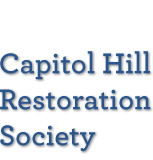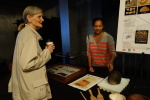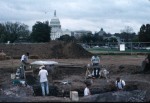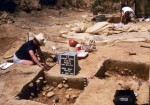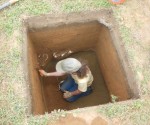Preservation Cafe: Ruth Trocolli, City Archaeologist
Posted on October 19th, 2014
Dr. Ruth Trocolli, City Archaeologist with the Historic Preservation Office, was the featured speaker Wednesday, October 15, 2014 at Ebenezers Coffee House. She and her associates presented her office’s archaeological Investigations during the Freeway Modification projects at Barney Circle for the October Preservation Café. Various objects were also on display during the presentation. Original fragments of artifacts and reconstructed replicas of bowls were some of the objects available for viewing.
The Barney Circle Freeway Modification Project was part of a multi-year highway development project designed to link major roadways across the Anacostia River in Washington, D.C. Archaeological survey of the proposed development corridor began in 1984. Evaluation studies of six archaeological sites found in the survey were conducted in 1989. Four of the sites were recommended eligible for NRHP nomination, and data recovery excavations were conducted in 1994.
The archaeological sites lay on opposite banks of the Anacostia River in Washington, D.C. The Anacostia River in Washington, D.C., is wide and slow moving, a perfect combination for early settlement. The river is part of the upper end of the great Chesapeake Bay estuary and is influenced by tides. The banks of the Anacostia River have changed over the years from urban development. Silting from agricultural run-off that began with the clearing of forests for tobacco farming closed the deepwater port of Bladensburg by the early 19th century. In the early 20th century the US Army Corps of engineers dredged the channel of the river. They used much of the spoil to reclaim low-lying, marshy ground along the edges of the stream, as well as creating what is today Kingman Island.
Due to all this development, the archaeological sites on both sides of the river lay under substantial amounts of fill dirt. The fill ranged from as little as 2 feet thick to as much as 15 feet. Heavy equipment was needed to assist in removing the fill to expose the sensitive archaeological sites below.
Once excavated, a dark occupation layer is visible and is distinct from the disturbed layers above it (These layers are lighter due to occupation, plowing, and construction over time). Archaeological evidence from the occupation layer included Late Archaic/Early Woodland artifacts, such as Holmes points and groups of steatite vessel sherds (including rim, heel and base fragments). Somewhat later artifacts included Accokeek sherds and sherds tempered with steatite, hornblende or schist.
One interesting find was a deep pit feature that contained a cluster of fire-cracked rock. These rocks were typically used to heat water and cook in a leather-lined pit. Another discovery was a concentration of nearly 1,500 quartzite fragments of flaking debris along with a group of quartzite biface fragments. The artifacts appeared to be the remnants of a lithic workshop area.
Because of pubic opposition and budget issues, the Barney Circle highway project was eventually cancelled. But a Memorandum of Understanding from 1983 required the site analyses and technical reporting to be completed. A recent Transportation Enhancement Grant secured by the DC Historic Preservation Office in 2011 provided funding for the work, and this presentation was one of the results of that activity.
The sites were only small samples of the larger areas and because there were no direct impacts from construction, substantial portions of each site remain for future study. While the Barney Circle study confirmed the general extent and intensity of occupation in the region, there is still much to learn about prehistoric use of the Anacostia River Valley. The research conducted during the Barney Circle Freeway project also provided another demonstration that significant archaeological sites survive in seemingly developed urban settings. We should continue to look carefully at proposed development impacts in similar areas in the future.
